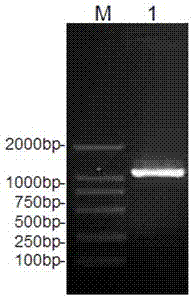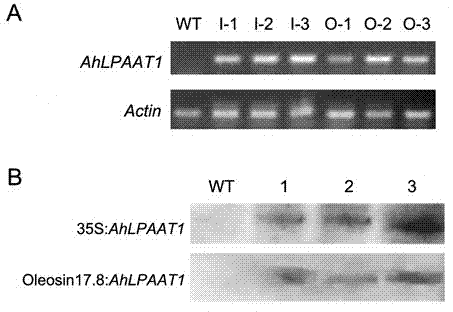A peanut lysophosphatidic acid acyltransferase gene and its application
A technology of lysophosphatidic acid and acyltransferase, which is applied in the field of molecular biology and biology, and can solve the problems of limited selection of acyl CoA
- Summary
- Abstract
- Description
- Claims
- Application Information
AI Technical Summary
Problems solved by technology
Method used
Image
Examples
Embodiment 1
[0062] peanut AhLPAAT1 Gene cloning and recombination vector pGEM-T- AhLPAAT1 build
[0063] (1) Extraction of total RNA from peanut seeds
[0064] 1) Weigh 0.1g of peanut seeds, grind them into powder in liquid nitrogen, and quickly transfer them to a 1.5ml centrifuge tube;
[0065] 2) Add 1ml Trizol extract to the centrifuge tube, mix well, and place at room temperature for 5 minutes;
[0066] 3) Add 0.2ml of chloroform to the centrifuge tube, shake vigorously for 15s, place at room temperature for 3min, centrifuge at 12000rpm for 15min at 4°C, carefully absorb 200μl of the upper aqueous phase and add to another centrifuge tube;
[0067] 4) Repeat 3) until most of the protein is removed, place in isopropanol (0.8 times the volume) at room temperature for 10 minutes, then centrifuge at 12000g for 10 minutes at 4°C;
[0068] 5) Discard the supernatant, add 1ml of 75% ethanol, centrifuge at 7,500g at 4°C for 5min; discard the supernatant, add 1ml of absolute ethanol, ce...
Embodiment 2
[0088] Construction of Plant Overexpression Vectors
[0089] (1) Overexpression vector pBI121- AhLPAAT1 Recombinant vector and pBIOle17.8- AhLPAAT1 Construction of recombinant vector
[0090] Using pBI121 vector with 35S promoter and pOlesin17.8- GUS vector for the construction of plant overexpression vector, pOlesin17.8- GUS The vector was constructed by replacing the 35S promoter of the pBI121 vector with the peanut Olesin17.8 promoter. Based on the MCS of the pBI121 vector Sma I and Sac I restriction site and AhLPAAT1 A pair of primers were designed for the sequences at both ends of the cDNA, plus restriction enzyme sites and protective bases (the underlined sequence is the enzyme site):
[0091] Forward primer: 5'-TCC CCCGGG ATGACTACCACTGGGACACTCAAG-3'
[0092] Reverse primer: 5'-C GAGCTC TCATTTTTCTCCAAACGCCGTAGC-3'
[0093] The PCR reaction system is: 0.5 μl pGEM-T- AhLPAAT1 Intermediate vector plasmid, 1 μl dNTP Mixture (10mM), 2 μl forward primer (...
Embodiment 3
[0098] Genetic Transformation of Arabidopsis
[0099] (1) Pre-treatment of Arabidopsis transformation: Arabidopsis plants can be used for transformation when the main fur grows to 5-6cm and begins to bloom and form 1-2 siliques. The grown siliques need to be cut off before transformation.
[0100] (2) Preparation of dipping medium: The dipping medium used to soak Arabidopsis inflorescences is 1 / 2MS medium containing 5% sucrose, pH=5.8 (adjusted by KOH), and autoclaved. When used, add 0.02%-0.05% surfactant Silwet L-77.
[0101] (3) Agrobacterium preparation and Arabidopsis transformation:
[0102] 1) Activation of strains: Put the preserved transformed Agrobacterium tumefaciens EHA105 strains on YEB solid medium containing kanamycin (Km, 100 mg / L) and rifampicin (Rif, 30 mg / L) Activate the upper line, and pick a single colony for PCR detection;
[0103] 2) Pick the activated monoclonal positive Agrobacterium containing the target gene into 5ml of fresh YEB medium containing...
PUM
 Login to View More
Login to View More Abstract
Description
Claims
Application Information
 Login to View More
Login to View More - R&D
- Intellectual Property
- Life Sciences
- Materials
- Tech Scout
- Unparalleled Data Quality
- Higher Quality Content
- 60% Fewer Hallucinations
Browse by: Latest US Patents, China's latest patents, Technical Efficacy Thesaurus, Application Domain, Technology Topic, Popular Technical Reports.
© 2025 PatSnap. All rights reserved.Legal|Privacy policy|Modern Slavery Act Transparency Statement|Sitemap|About US| Contact US: help@patsnap.com



